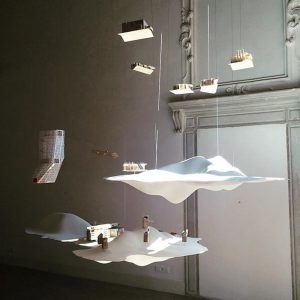
Image: New Zealand Pavilion, Venice Biennale, 2016
“…Architect’s can no longer afford to be intimidated by the puritanically moral language of orthodox Modern architecture. I like elements which are hybrid rather than “pure”, compromising rather than “clean”, distorted rather than “straightforward”, ambiguous rather than “articulated”, perverse as well as impersonal, boring as well as “interesting”, conventional rather than “designed”, accommodating rather than excluding, redundant rather than simple, vestigial as well as innovating, inconsistent and equivocal rather than direct and clear. I am for messy vitality over obvious unity. I include the non sequitur and proclaim the duality…” [Robert Venturi, Complexity & Contradiction in Architecture, 1966]
The Future’s Past is a literary term coined by Philip Fisher (1975) that examines the process of how objects become defined as cultural artifacts within a museum. U20 will examine the transition from object to artifact in spatial and narrative terms, uncovering architectural portals, wormholes and shifts that define The Future’s Past; in search of a transtemporal architectural language of now.
‘Complexity & Contradiction in Architecture’ by Robert Venturi (1966 published by The Museum of Modern Art), was both radical and unusual for it’s time; originally published as a catalogue without an exhibition, as a manifesto of critical thinking by an architect whose primary concern was making buildings. Fifty years on, it’s relevance remains and U20 will re-examine the contemporary themes explored in Complexities and Contradiction in Architecture in our own investigations between London, Rome and Venice in a process that will uncover each student’s own individual architectural language.
U20 is a testing ground for hybrid architectural design, a place to establish polemic concepts that explore; collections, architectural curation and their impact on the contemporary urban condition. U20 is interested in how the intersections and slippages between analogue and digital modes of communication can inform the architectural drawing and how the model can acts as a prop and trope for representing and subverting architecture; through humour, landscape, scale, exhibition, performance, display, magic and seduction.
The Future’s Past will examine Rome & Venice, exploring both the timeless and ancient layered city of Rome and the temporal and ever-changing ‘temporary city within a city’ formed by exhibitions that inhabit the arsenale during the Venice Biennale. In particular the unit will examine the spaces between collections and container, objects and display, the material and immaterial, in defining a new architecture.
Project 01 – Roma Interrotta 2078
For Urban Design Year 1 students will situate their projects within the intellectual urban design issues surrounding the seminal exhibition Roma Interrotta [1978], a reworking Giambattista Nolli’s plan of Rome [1748]. Projects will be sited in London or Rome and will explore the politics and polemics of the contemporary urban fabric of the city to define an urban design strategic methodology.
Year 2 students will investigate The Future’s Past through research of the collections and archives of unbuilt architectures; from the RIBA’s Architecture Collection, London to the Fonds Régional d’Art Contemporain [FRAC], ARCHI-DEPOT, Tokyo, Het Nieuwe Instituut, Rotterdam, Canadian Centre for Architecture [CCA], and the Tchoban Foundation, Berlin. Year 2 students will define their own themes of interest drawn from a collection of their choice.
Both years will deconstruct the image as building, as model, as vehicle for a spectacular tool and a lens through which to examine the material and psychological aspects of future architecture.
Project 02 – The Delirious Museum
Year 1 students will define their own notions of the ‘Delirious’ applying this to the design of a small museum or archive which will form the basis of the Design Realisation project, sited in London, Venice or Rome which is the main building project of Y1 for the year.
Year 2 students will develop their own intellectual interests from the themes developed from project 1 in conjunction with their thesis and overall themes of the year. Project sites will be supported by U20 and selected accord to the brief established by